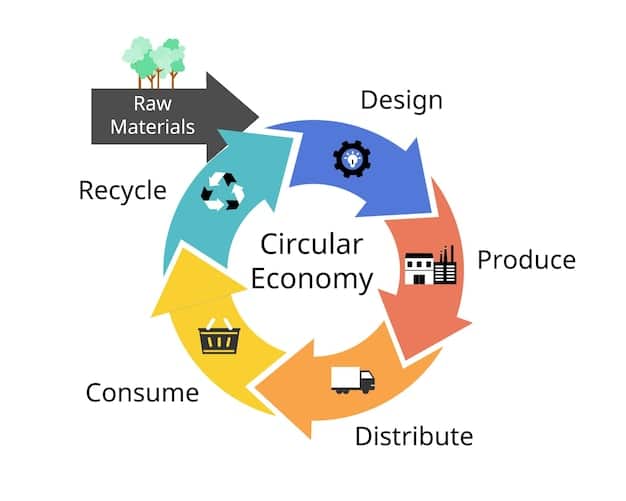US Businesses Embrace Sustainability: Trends and Responses

US businesses are increasingly responding to the demand for sustainable products and practices by adopting eco-friendly initiatives, investing in renewable energy, and promoting ethical sourcing to meet consumer expectations and regulatory requirements.
How are US businesses responding to the increasing demand for sustainable products and practices? The answer lies in a multifaceted approach that encompasses everything from operational changes to innovative product development, driven by consumer awareness and a growing recognition of environmental responsibility.
Sustainability as a Core Business Value
Sustainability is no longer just a buzzword; it has become a core value for many US businesses. Companies are integrating sustainable practices into their mission statements and long-term strategies, reflecting a fundamental shift in how they operate and perceive their role in society.
This transformation is driven by a combination of factors, including increasing consumer demand for eco-friendly products, stricter environmental regulations, and a growing awareness of the long-term benefits of sustainable business models.
The Rise of Eco-Conscious Consumers
Consumers are becoming more informed and discerning about the environmental impact of their purchasing decisions. They are actively seeking out brands that demonstrate a commitment to sustainability and are willing to pay a premium for products that are ethically sourced and environmentally friendly.
Regulatory Pressures and Incentives
Federal and state governments are implementing stricter environmental regulations and offering incentives for businesses that adopt sustainable practices. These regulations cover a wide range of issues, including emissions, waste management, and resource conservation.
- Investing in Renewable Energy: Many companies are transitioning to renewable energy sources, such as solar and wind power, to reduce their carbon footprint and lower energy costs.
- Adopting Circular Economy Principles: Businesses are embracing circular economy models that prioritize waste reduction, recycling, and the reuse of materials.
- Promoting Ethical Sourcing: Companies are implementing policies to ensure that their supply chains are free from human rights abuses and environmental degradation.
In conclusion, US businesses are increasingly prioritizing sustainability as a core business value, driven by consumer demand, regulatory pressures, and a growing awareness of the long-term benefits of sustainable business models.

Sustainable Supply Chain Management
One of the most significant ways US businesses are responding to the demand for sustainability is by focusing on sustainable supply chain management. This involves evaluating and improving the environmental and social impact of every stage of the supply chain, from raw material extraction to product distribution.
Companies are working with their suppliers to implement sustainable practices, reduce waste, and promote ethical labor standards. This collaborative approach is essential for creating a truly sustainable business model.
Implementing Traceability Systems
Traceability systems allow businesses to track the origin and journey of their products, ensuring that they are sourced from sustainable and ethical sources. These systems can help to prevent deforestation, human rights abuses, and other harmful practices.
Reducing Transportation Emissions
Transportation is a major contributor to greenhouse gas emissions. Businesses are working to reduce their transportation emissions by optimizing logistics, using more fuel-efficient vehicles, and exploring alternative modes of transportation, such as rail and electric vehicles.
- Supplier Audits and Certifications: Conducting regular audits of suppliers to ensure compliance with sustainability standards and seeking certifications from reputable organizations.
- Collaborative Partnerships: Working closely with suppliers to implement sustainable practices and share best practices.
- Investing in Sustainable Packaging: Using recycled, biodegradable, or compostable packaging materials to reduce waste and environmental impact.
In summary, sustainable supply chain management is a critical component of US businesses’ response to the demand for sustainability, involving traceability systems, reduced transportation emissions, and collaborative partnerships with suppliers.
Investing in Renewable Energy and Energy Efficiency
Another key strategy for US businesses is investing in renewable energy and energy efficiency. This involves adopting technologies and practices that reduce energy consumption and reliance on fossil fuels, leading to both environmental and economic benefits.
Many companies are installing solar panels, wind turbines, and other renewable energy systems on their properties. They are also implementing energy-efficient lighting, heating, and cooling systems to reduce their overall energy consumption.
On-Site Renewable Energy Generation
Generating renewable energy on-site can significantly reduce a business’s carbon footprint and energy costs. Solar panels are a popular option for businesses of all sizes, while wind turbines may be suitable for companies located in areas with strong winds.
Energy-Efficient Building Design
Designing and constructing energy-efficient buildings can dramatically reduce energy consumption. This involves using sustainable building materials, optimizing insulation, and incorporating natural lighting and ventilation.
- Retrofitting Existing Buildings: Upgrading existing buildings with energy-efficient technologies, such as LED lighting and smart thermostats.
- Participating in Energy Efficiency Programs: Taking advantage of government and utility programs that offer rebates and incentives for energy efficiency improvements.
- Utilizing Smart Grid Technologies: Implementing smart grid technologies to monitor and optimize energy consumption in real-time.
In conclusion, investing in renewable energy and energy efficiency is a crucial step for US businesses in their commitment to sustainability, with on-site renewable energy generation, energy-efficient building design, and retrofitting existing buildings playing key roles.

Embracing Circular Economy Models
The circular economy is an economic system aimed at minimizing waste and making the most of resources. US businesses are increasingly embracing circular economy models to reduce their environmental impact and create new business opportunities.
This involves designing products for durability, repairability, and recyclability. It also includes implementing systems for collecting and reusing materials, as well as offering product take-back programs.
Product Design for Durability and Repairability
Designing products that are built to last and easy to repair can significantly reduce waste and extend the lifespan of products. This involves using high-quality materials, designing modular components, and providing repair manuals and spare parts.
Implementing Product Take-Back Programs
Product take-back programs allow customers to return used products to the manufacturer for recycling or refurbishment. This helps to prevent waste and ensures that valuable materials are recovered.
- Material Recovery and Recycling: Implementing systems for collecting and processing recyclable materials, such as plastics, metals, and paper.
- Remanufacturing and Refurbishment: Restoring used products to like-new condition through remanufacturing and refurbishment processes.
- Sharing Economy Platforms: Participating in sharing economy platforms that allow customers to rent or borrow products instead of owning them.
In summary, embracing circular economy models is an essential strategy for US businesses to reduce waste and maximize resource utilization, with product design for durability, product take-back programs, and material recovery and recycling being key elements.
Sustainable Product Development and Innovation
US businesses are also responding to the demand for sustainability by focusing on sustainable product development and innovation. This involves creating new products and services that are environmentally friendly and socially responsible.
Companies are using sustainable materials, reducing packaging waste, and designing products that are energy-efficient and long-lasting. They are also exploring new business models that promote sustainability, such as product-as-a-service.
Using Sustainable Materials
Using sustainable materials, such as recycled plastics, bamboo, and organic cotton, can significantly reduce the environmental impact of products. This involves sourcing materials from sustainable sources and minimizing the use of harmful chemicals.
Reducing Packaging Waste
Packaging waste is a major environmental problem. Businesses are working to reduce packaging waste by using minimal packaging, using recycled and biodegradable materials, and encouraging customers to recycle.
- Designing for Energy Efficiency: Creating products that consume less energy during use, such as energy-efficient appliances and electronics.
- Developing Eco-Friendly Alternatives: Developing alternatives to traditional products that have a lower environmental impact, such as plant-based cleaning products and biodegradable plastics.
- Promoting Product-as-a-Service: Offering products as a service instead of selling them outright, which encourages manufacturers to design for durability and longevity.
In conclusion, sustainable product development and innovation are crucial for US businesses to meet the growing demand for environmentally friendly and socially responsible products, focusing on sustainable materials, reducing packaging waste, and designing for energy efficiency.
Transparency and Reporting on Sustainability Efforts
Transparency and reporting are essential for building trust with consumers and stakeholders. US businesses are increasingly reporting on their sustainability efforts, providing information on their environmental and social performance.
This involves publishing sustainability reports, disclosing environmental data, and participating in third-party sustainability certifications. By being transparent, companies can demonstrate their commitment to sustainability and hold themselves accountable for their actions.
Publishing Sustainability Reports
Sustainability reports provide a comprehensive overview of a company’s environmental and social performance. These reports typically include information on energy consumption, greenhouse gas emissions, waste generation, water usage, and social responsibility initiatives.
Disclosing Environmental Data
Disclosing environmental data allows stakeholders to track a company’s progress on sustainability goals. This data can be disclosed through various channels, such as annual reports, websites, and environmental databases.
- Participating in Sustainability Certifications: Obtaining certifications from reputable organizations, such as B Corp and LEED, to demonstrate commitment to sustainability.
- Engaging with Stakeholders: Engaging with employees, customers, investors, and other stakeholders to gather feedback on sustainability efforts and address concerns.
- Setting Measurable Goals: Setting specific, measurable, achievable, relevant, and time-bound (SMART) goals for sustainability improvements.
In summary, transparency and reporting are vital for US businesses to build trust and demonstrate their commitment to sustainability, with publishing sustainability reports, disclosing environmental data, and participating in sustainability certifications being key actions.
| Key Point | Brief Description |
|---|---|
| ♻️ Supply Chain | Focus on ethically sourced materials and waste reduction. |
| ☀️ Renewable Energy | Investing in solar panels and wind turbines. |
| 🔄 Circular Economy | Adopting models to minimize waste and reuse resources. |
| 🌱 Product Innovation | Creating sustainable and responsible products. |
Frequently Asked Questions
▼
US businesses are focusing on sustainability due to increased consumer demand, stricter regulations, and a growing awareness of the long-term benefits of eco-friendly practices.
▼
Common sustainable practices include investing in renewable energy, adopting circular economy models, and promoting ethical sourcing in supply chains.
▼
Sustainable supply chain management helps businesses reduce waste, ensure ethical sourcing, and improve their overall environmental impact and social responsibility.
▼
Transparency builds trust with consumers and stakeholders by providing information on environmental and social performance through reports and data disclosures.
▼
Businesses are incorporating renewable energy through on-site generation with solar panels or wind turbines, improving energy efficiency in buildings, and utilizing smart grid technologies.
Conclusion
In conclusion, US businesses are actively responding to the increasing demand for sustainable products and practices through a variety of strategies, including sustainable supply chain management, investments in renewable energy, embracing circular economy models, and promoting transparency. These efforts reflect a growing recognition of the importance of sustainability for both business success and environmental stewardship.





